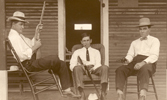Part two of Channel's 'Chronicles' examines local connection to JFK assassination, 1933 Anderson murder
Contact: Christina Chapple
10/6/08
Click on thumbnail for high resolution photo
(1) (2)
(2) 
Captions …
(1) CHANGED VIOLENCE IN HAMMOND – The murder of Gordon Anderson, the Hammond city marshal who was killed in the line of duty in 1933, will be featured in the latest installment of The Southeastern Channel’s program "The Florida Parish Chronicles," debuting Monday, Oct. 13, 7 p.m., and airing on subsequent Mondays and Wednesdays on Charter Cable Channel 18 in Tangipahoa, Livingston and St. Tammany parishes, Channel 17 in Washington Parish, and online at www.selu.edu.
(2) FLORIDA PARISHES CRIMINALS, PART TWO -- Post-Reconstruction violence ran wild in the Florida Parishes in the 1930s. "Part Two: Legendary Crimes and Criminals of the Florida Parishes," a new episode of the Southeastern Channel’s “The Florida Parish Chronicles,” explores how the death in the line of duty of Hammond city marshal Gordon Anderson signaled the change of such violent attitudes.
These questions are answered in the latest episode of the Emmy-nominated series, “The Florida Parish Chronicles,” airing on the Southeastern Channel, Southeastern Louisiana University’s educational cable television access channel on Charter Cable Channel 18.
“Part Two: Legendary Crimes and Criminals of the Florida Parishes” will debut Monday, Oct. 13, 7 p.m., and will continue airing at that time on Mondays and Wednesdays.
Part one of “Crimes and Criminals,” which debuted last October, spotlighted famed train robber Eugene Bunch and the controversial hanging of six Italians for a 1920s Independence murder.
Part two explores the mysterious 1963 appearances together in various parts of the Florida Parishes of three key JFK assassination figures and alleged conspirators -- accused lone gunman Lee Harvey Oswald, his reputed associate David Ferry, and Kentwood native Clay Shaw, head of New Orleans’ International Trade Mart.
The show also describes the 1933 murder of Hammond City Marshal Gordon Anderson, the only Hammond city peace officer to die in the line of duty.
Channel General Manager Rick Settoon, the show’s executive producer, said the show “mixes the intrigue of local involvement in the highest profile murder mystery in American history with the inspirational impact of how one man’s heroic act changed the course of violence in both Hammond and Tangipahoa Parish.”
The “Florida Parish Chronicles” host and writer is Samuel C. Hyde Jr., Southeastern’s Ford Family Chair in Regional Studies and director of the Center for Southeast Louisiana Studies.
“This episode demonstrates that developments in the Florida Parishes often directly impacted circumstances of national consequence -- such as in the case of the mysterious Oswald link to our area,” Hyde said.
“The death of a police officer, killed in the line of duty, served to advance popular demands for an honest and effective legal establishment, as well as revealing that race relations in our area may not have been as dire as previously concerned,” Hyde added. “It is an episode to educate as much as it will entertain.”
In the JFK assassination segment, Hyde interviews Kennedy assassination expert Michael Kurtz, Southeastern’s professor emeritus of history. Kurtz, who taught a Southeastern JFK assassination course for nearly 40 years and authored such notable titles as “Crime of the Century: The Kennedy Assassination from a Historian’s Perspective,” describes how Oswald, Ferry and Shaw were spotted together in the Florida Parishes on a number of occasions only months and even weeks prior to the 1963 assassination.
Cited locations range from the CIA’s anti-Castro training base in Lacombe to a line of black voters in Clinton. Kurtz says questions still abound as to whether Oswald was being portrayed as Communist or anti-Communist and if he was framed for the assassination.
The Marshal Anderson story is set against the backdrop of “Bloody Tangipahoa,” an era of rampant violence throughout the parish spawned by bitter reactions to Reconstruction. Many in Hammond complained of the lack of competent law enforcement. In 1932 the town set a record for killings.
Into this cauldron sprang Isadore Marsh, a drifter and thief known to make his escape by jumping trains. When Marshal Anderson confronted and arrested Marsh, he attacked the police officer, seized his weapon, and shot him to death on the railroad tracks in downtown Hammond.
Despite mobs clamoring for revenge, the Anderson family and local officials pled for calm and maintaining the integrity of the justice system. The response signified a departure from the days of “Bloody Tangipahoa” retribution and a new willingness on the part of area residents to put their faith in local law enforcement.
The Gordon Anderson story is brought to life by dramatic reenactments, historical footage and archival photographs. At the site of the 1933 murder, Hyde interviews Anderson’s grandson, Hammond attorney and former city mayor Tom Anderson, brother of current city marshal Gordon Anderson.
Southeastern Channel staff member Josh Kapusinski edited the program, while Steve Zaffuto produced and directed the reenactments. Channel staffers David Fox and Jamie Bass videotaped the production, while the Center for Southeast Regional Studies assisted with research.
In five years of existence, the Southeastern Channel has won more than 70 national and international awards. The channel airs on Charter Cable Channel 18 in Tangipahoa, St. Tammany and Livingston parishes, Channel 17 in Washington Parish, and online at www.selu.edu/tv.
More News...
